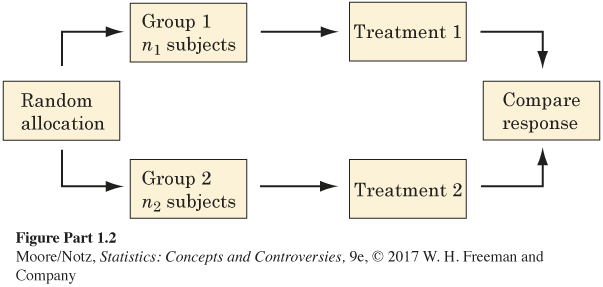PART I REVIEW
203
PART I REVIEW
The first and most important question to ask about any statistical study is “Where do the data come from?’’ Chapter 1 addressed this question. The distinction between observational and experimental data is a key part of the answer. Good statistics starts with good designs for producing data. Chapters 2, 3, and 4 discussed sampling, the art of choosing part of a population to represent the whole. Figure I.1 summarizes the big idea of a simple random sample. Chapters 5 and 6 dealt with the statistical aspects of designing experiments, studies that impose some treatment in order to learn about the response. The big idea is the randomized comparative experiment. Figure I.2 outlines the simplest design.
Random sampling and randomized comparative experiments are perhaps the most important statistical inventions of the twentieth century. Both were slow to gain acceptance, and you will still see many voluntary response samples and uncontrolled experiments. Both random samples and randomized experiments involve the deliberate use of chance to eliminate bias and produce a regular pattern of outcomes. The regular pattern allows us to give margins of error, make confidence statements, and assess the statistical significance of conclusions based on samples or experiments.
204


When we collect data about people, ethical issues can be important. Chapter 7 discussed these issues and introduced three principles that apply to any study with human subjects. The last step in producing data is to measure the characteristics of interest to produce numbers we can work with. Measurement was the subject of Chapter 8. “Where do the data come from?’’ is the first question we should ask about a study, and “Do the numbers make sense?’’ is the second. Chapter 9 encouraged the valuable habit of looking skeptically at numbers before accepting what they seem to say.